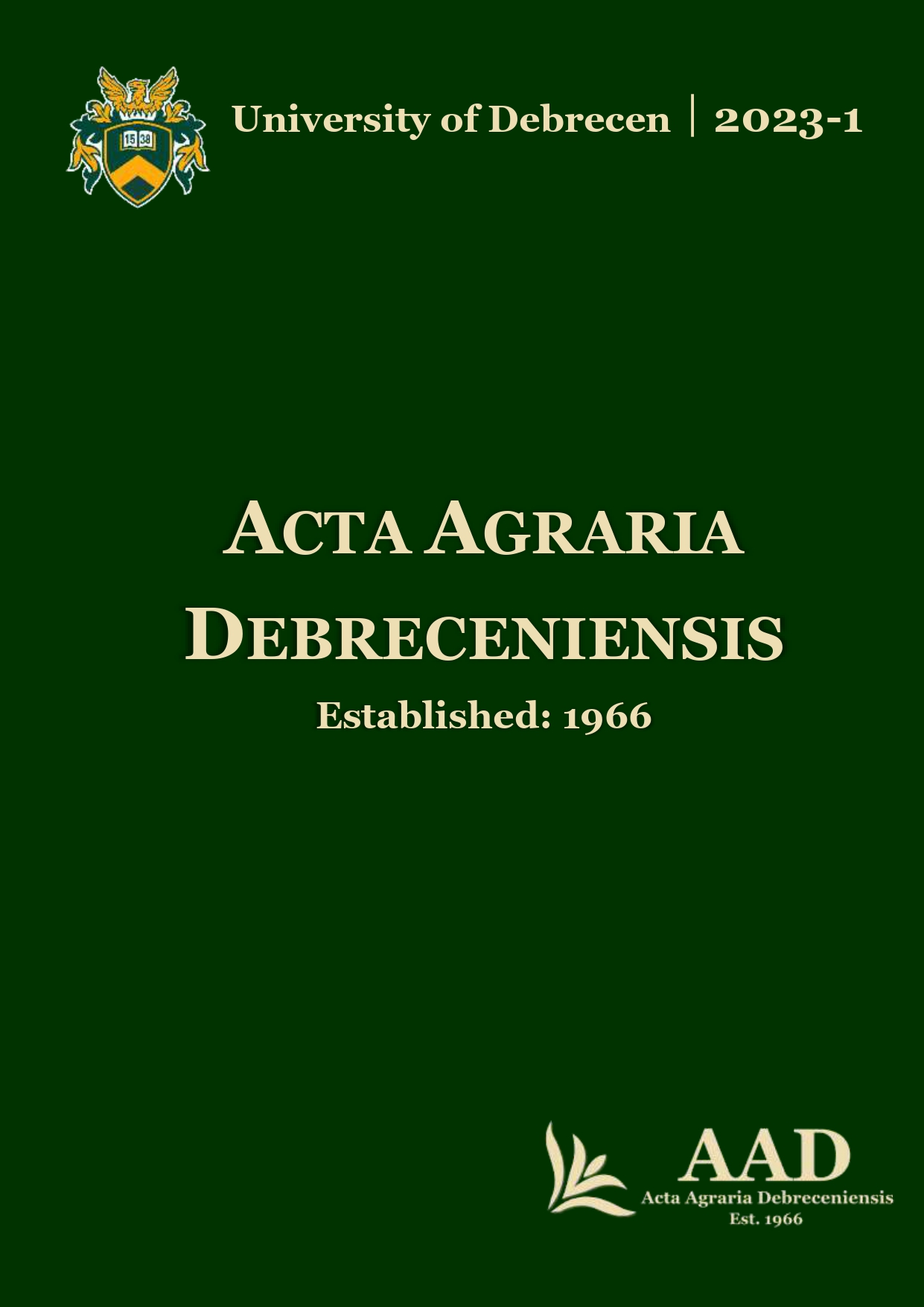Leaf reflectance characteristics and yield of spring oat varieties as influenced by varietal divergences and nutritional supply
Authors
View
Keywords
License
Copyright (c) 2023 by the Author(s)

This work is licensed under a Creative Commons Attribution 4.0 International License.
How To Cite
Accepted 2023-03-23
Published 2023-06-05
Abstract
Inadequacy of nutrients in the soil and sufficient inaccessibility to nutrients is caused by factors that affect production and productivity of spring oat varieties. Exogenous application of nutrient and real time nutrient assessment can therefore reverse these associated negative consequences. A field experiment was conducted to evaluate the response of spring oat varieties to sulphur and silicon based fertilisation. Eight spring oat varieties, four level of nutrient application was arranged in a split-plot design with three replications. The obtained results showed that foliar application of sulphur improves the grain yield of most nutrients responsive varieties by about 34.7%. However, application of silicon had shown a diminishing return association to grain yield of variety GK Kormorán, GK Pillangó, Lota, Panni. LAI, thousands grain weight, SPAD, NDVI was significantly (p < 0.05) influenced by genetic difference of the tested varieties, developmental plasticity, and nutrient application. Significantly higher grain yield was obtained from the variety Mv Pehely than the other tested varieties. Therefore, it could be inferred that a combined use of nutrient responsive spring oat varieties and sulphur containing fertilisers could be important agronomic practice to improve grain yield and to develop climate resilient oat varieties.
References
- Fertilisation on Maize Performance Under Limited Water Supply. Silicon 10, 177–183. https://doi.org/10.1007/s12633-015-9372-x
- Aula, L.–Dhillon, J.S.–Omara, P.–Wehmeyer, G.–Freeman, K.W.–Raun, W.R. (2019): Sulphur Use Efficiency for Cereal Crops. Agronomy Journal Volume 111, Issue 5 p. 2485–2492. https://doi.org/10.2134/agronj2019.02.0095
- Chen, C.Y.–Milbury, P.E.–Collins, F.W.–Blumberg, J.B. (2007): Avenanthramides are bioavailable and have antioxidant activity in humans after acute consumption of an enriched mixture from oats. J Nutr. 2007 Jun;137(6):1375–82. doi: 10.1093/jn/137.6.1375. PMID: 17513394.
- Csajbók, J.–Buday-Bódi, E.–Nagy, A.–Fehér, Zs.Z.–Tamás, A.–Virág, I.Cs.–Bojtor, Cs.–Forgács, F.–Vad, A.M..–Kutasy, E.. (2022): "Multispectral Analysis of Small Plots Based on Field and Remote Sensing Surveys—A Comparative Evaluation" Sustainability 14, no. 6: 3339. https://doi.org/10.3390/su14063339
- Foulkes, M.J.–Slafer, G.A.–Davies, W.J–Berry, P.M.–Sylvester-Bradley, R.–Martre, P.–Calderini, D.F.–Griffiths, S.–Reynolds, M.P. (2011): Raising yield potential of wheat. III. Optimizing partitioning to grain while maintaining lodging resistance, Journal of Experimental Botany, Volume 62, Issue 2, January 2011, Pages 469–486, https://doi.org/10.1093/jxb/erq300
- Gupta, A.–Rico-Medina, A.–Caño-Delgado, A.I. (2020): The physiology of plant responses to drought. Science. 2020 Apr 17;368(6488):266–269. doi: 10.1126/science.aaz7614. PMID: 32299946.
- Hanafy Ahmed, A.H–Harb, E.M.–Higazy, M.A.–Morgan, S.H. (2008): Effect of silicon and boron foliar applications on wheat plants grown under saline soil conditions. Int. J. Agric. Res. 3, 1–26. DOI: 10.3923/ijar.2008.1.26
- Kizilgeci, F.–Yildirim, M.–Islam, M.S.–Ratnasekera, D.–Iqbal, M.A.–Sabagh, A.E. (2021): "Normalized Difference Vegetation Index and Chlorophyll Content for Precision Nitrogen Management in Durum Wheat Cultivars under Semi-Arid Conditions" Sustainability 13, no. 7: 3725. https://doi.org/10.3390/su13073725
- Kovács, Sz.–Kutasy, E.–Csajbók, J. (2022): "The Multiple Role of Silicon Nutrition in Alleviating Environmental Stresses in Sustainable Crop Production" Plants 11, no. 9: 1223. https://doi.org/10.3390/plants11091223
- Kutasy, E.–Buday-Bódi, E.–Virág, I.C.–Forgács, F.–Melash, A.A.–Zsombik, L.–Nagy, A.–Csajbók, J. (2022): Mitigating the Negative Effect of Drought Stress in Oat (Avena sativa L.) with Silicon and Sulphur Foliar Fertilisation. Plants 2022, 11, 30. https://doi.org/10.3390/plants11010030
- Ming, D.F.–Pei, Z.F.–Naeem, M.S.–Gong, H.J.–Zhou, W.J. (2012): Silicon Alleviates PEG-Induced Water-Deficit Stress in Upland Rice Seedlings by Enhancing Osmotic Adjustment. Journal of Agronomy and Crop Science, 198: 14–26. https://doi.org/10.1111/j.1439-037X.2011.00486.x
- Mirosavljević, M.–Momčilović, V.–Čanak, P.–Aćin, V.–Jocković, B.–Vujošević, B. (2018): "Variation in NDVI values and relationship with grain yield in two-rowed winter barley." Ratarstvo i povrtarstvo 55, no. 3 118–124. https://doi.org/10.5937/RatPov1803118M.
- Okuno, A,–Hirano, K.–Asano, K.–Takase, W.–Masuda, R.–Morinaka, Y.–Ueguchi-Tanaka, M.–Kitano, H.–Matsuoka, M. (2014): New approach to increasing rice lodging resistance and biomass yield through the use of high gibberellin producing varieties. PLoS One. 2014 Feb 19;9(2):e86870. doi: 10.1371/journal.pone.0086870. PMID: 24586255; PMCID: PMC3929325.
- Qi, H.–Zhu, B.–Kong, L.–Yang, W.–Zou, J.–Lan, Y.–Zhang, L. (2020): "Hyperspectral Inversion Model of Chlorophyll Content in Peanut Leaves" Applied Sciences 10, no. 7: 2259. https://doi.org/10.3390/app10072259
- Reynolds, M.–Foulkes, M.J.–Slafer, G.A.–Berry, P.–Parry, M.A.J.– Snape, J.W.–Angus, W.J. (2009): Raising yield potential in wheat, Journal of Experimental Botany, Volume 60, Issue 7, May 2009, Pages 1899–1918, https://doi.org/10.1093/jxb/erp016
- Santos, A.F.B. dos–Teixeira, G.C.M.–Campos, C.N.S.–Baio, F.H.R.–Prado, R. de M.–Teodoro, L.P.R.–Vilela, R.G.–Paiva Neto, V.B. de–Teodoro, P.E. (2020): Silicon increases chlorophyll and photosynthesis and improves height and NDVI of cotton (Gossypium hirsutum L. r. latifolium Hutch). Research, Society and Development, [S. l.], v. 9, n. 7, p. e548973826, 2020. DOI: 10.33448/rsd-v9i7.3826.
- Shah, S.H.–Islam, S. –Mohammad, F. (2022): Sulphur as a dynamic mineral element for plants: a review. J Soil Sci Plant Nutr 22, 2118–2143. https://doi.org/10.1007/s42729-022-00798-9
- Soratto, R.P.–Crusciol, C.A.–Castro, G.S.–Costa, C.H.–Ferrari, N.J. (2012): Leaf application of silicic acid to white oat and wheat. Rev. Bras. Ciênc. Solo. 2012, 36, 1538–1544. https://doi.org/10.1590/S0100-06832012000500018
- Tang, Y.–Li, S.–Yan, J.–Peng, Y.–Weng, W.–Yao, X.–Gao. A.–Cheng, J.–Ruan, J.–Xu, B. (2022): Bioactive Components and Health Functions of Oat, Food Reviews International, DOI: 10.1080/87559129.2022.2029477
- Tosh, S.M.–Miller, S.S. (2016): Oats, Encyclopedia of Food and Health. Pages 119–125, https://doi.org/10.1016/B978-0-12-384947-2.00497-9.
- Xie, H.–Li, M.–Chen, Y.–Zhou, Q.–Liu, W.–Liang, G.–Jia, Z. (2021): Important Physiological Changes Due to Drought Stress on Oat. Front Ecol. Evol. (28 May 2021). https://doi.org/10.3389/fevo.2021.644726

 https://doi.org/10.34101/actaagrar/1/12144
https://doi.org/10.34101/actaagrar/1/12144